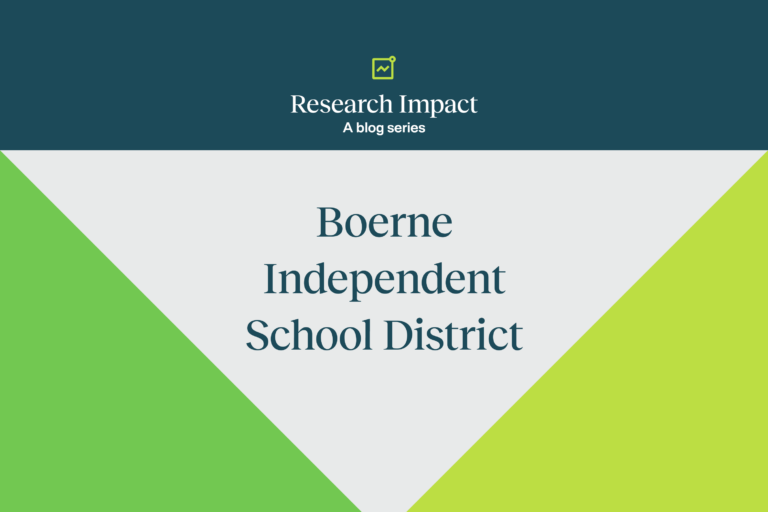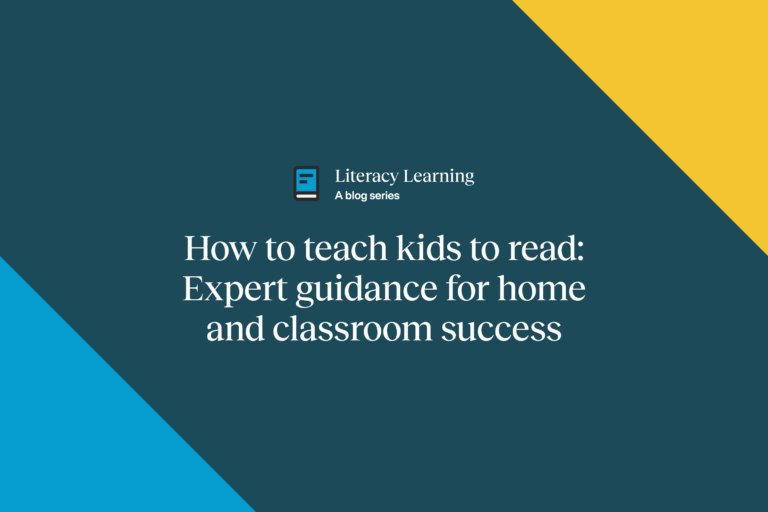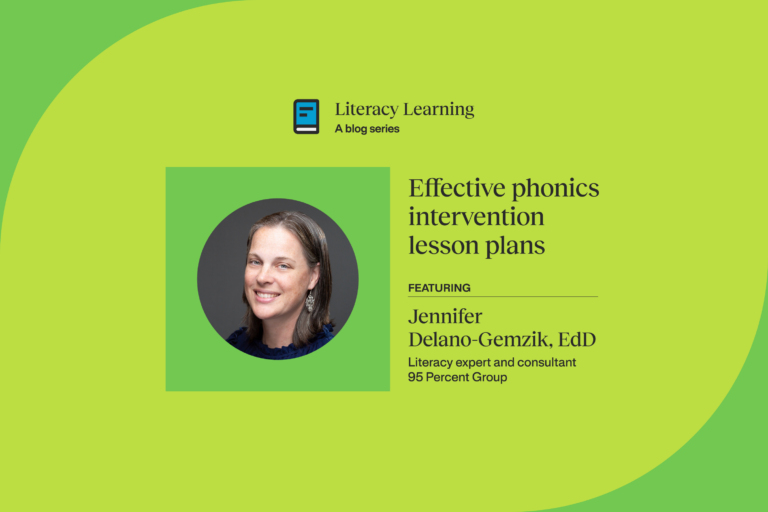Best practices for your Tier 2 literacy solution: Lessons learned from a California school district (Part 1)

Fairfax School District is located in a small community on the southeast side of Bakersfield, in Kern County, California. The district currently has four schools (they’re adding a fifth) with a total of 2688 students. In a previous interview, we spoke with David Mack about research-based best practices for implementing a Tier 1 phonics program.
For this new two-part interview, we circled back with David Mack, EdD, Chief Administrator of Business Services, to discuss the successful Tier 2 implementation that catalyzed Fairfax School District’s structured literacy journey. At David’s urging, we invited Charley Clark, Assistant Superintendent, to join us as well—Charley was the visionary literacy leader in the Tier 2 implementation.
A little background
Can you share what you learned in that initial Tier 2 implementation and the Tier 2 best practices that emerged?
David Mack:
We’re including Mr. Charley Clark in this conversation because Charley was instrumental in our school district’s 95 Percent Group Tier 2 implementation. Today, he is our assistant superintendent. He runs the entire instructional side of the district. I’m now on the business side. Charley is currently in the middle of his dissertation, so I picked his brain a lot for my dissertation. [See the post “Research-based best practices for implementing a Tier 1 phonics program” for details on Dr. Mack’s dissertation on implementation with fidelity.] Charley has a wealth of knowledge on implementation in general and on Tier 1, Tier 2, and Tier 3 strategies for reading intervention.
In the 2014-2015 school year, Charley was the principal of a brand new school, Zephyr Lane Elementary, and he had the opportunity to open it. In 2016, I got my first site as principal at Shirley Lane Elementary, so we were principals at the same time. Charley had brought 95 Percent Group’s Tier 2 curriculum to his new school right out the gate.
My site had an intervention program that, in my opinion, was not very effective. But given the culture of my school at the time, to go in and change it to something new, especially something that Zephyr Lane was implementing, would not have gone over well with the staff. That’s always a difficult spot when you come in as a principal and you want to implement change. So I had a year where I got to watch Charley implement it, and I could also take my staff members to go watch and talk with the Zephyr Lane team and see how the program was going.
Then, in my second year, I implemented it at my school, so we were a year behind Charley. It all started with us really wanting to have a universal screener for our students to get more information—at the time we went with Dibels. We now use Acadience.
Goals for year 1
Can you tell us about your initial goal for a Tier 2 implementation and your goal for student reading improvement?
Charley Clark:
The first year was the 2014-15 school year when I started with this school district, and as Dr. Mack mentioned, I got to open up a new school. In my previous district, we used Dibels and I was a Dibels trainer. We did Dibels “to the T” in our sites and we really used that data.
When I came to this new district, they were using Dibels, but it was not done to any kind of fidelity. One of my key tenets is: everything we do is data-driven. We always make sure we have the correct data to look at, so I was definitely planning on doing Dibels, but starting at a new school, you don’t want to be this outsider who comes in and just changes everything.
So I said, “We’re going to start with Kindergarten.” At that time, the reading program had teachers identifying their lowest-performing kids, but there was no data to drive the decision-making. So we started using Dibels with Kindergarten to really dig in to get specific groups. As Dr. Mack said about his school site, it was a culture shift that had to happen.
Then, when we started having data teams, it was exactly what I hoped would happen—first grade wanted it, then second grade, and third grade. Before I knew it, the whole school wanted to use Dibels because they were seeing us talk about data that they had never seen before.
Dibels—before and after
In your experience, what is the strength of Dibels that led you to want to shift to using it at your new school?
Charley Clark:
Before Dibels, we had zero ways to tell how our kids were doing. Everybody did their own thing. Some people did Rigby. Some people did Star. There was nothing universal. The district 10 years ago was not data-driven whatsoever in my opinion, and so we needed something. Dibels gives you nice reports, and the result is like, “Wow! We can really track growth!”—it’s a great product.
The big shift for change—my kids versus our kids
Charley Clark:
The effort steamrolled into getting targeted groups, and so now, instead of just “Send me your five lowest-performing kids,” we had to make the shift from “my kids” to “our kids.” If you just say, “Send me your five lowest-performing kids,” what if the 10 lowest kids are in one class? That “five lowest kids” approach doesn’t work.
After my first year, we got to the point where we had a reading specialist and our teacher on special assignment. We all attended an “I’ve Dibeled, Now What?” conference. And that’s where we got to see and meet Dr. Susan Hall, who was presenting 95 Percent Group and showing what you can do with it. We were all in from the get-go. It was such an amazing product. It just worked seamlessly with Dibels.
And it wasn’t hard to sell because it was so grounded with the Dibels levels. The best analogy I heard eight years ago that we still use is “Dibels tells you that there’s a fire. 95 Percent Group tells you what floor the fire is on, what room the fire is in, and what you need to put the fire out.” That’s been our elevator pitch on what 95 Percent Group is ever since.
Realizing we had a Tier 1 problem
Charley Clark:
So we started. I wanted a true intervention room. Before that, all of our Kindergarten teachers had their aides. My first unpopular decision when I became a principal was to pull all those Kindergarten aides and put them in a reading lab. We trained them on how to use 95 Percent Group. Today, we have this system-wide at all schools.
Our Tier 2 system was solid at this point, but kids kept coming in. The floodgates were just opened, and we realized that while we have a really good intervention program, our problem is really with Tier 1.
That’s when we adopted Tier 1—Dr. Mack brought that in. He was the first one to jump on the 95 Phonics Core Program®. We implemented it, and we are in our second full year with it. It’s seamless now from Tier 1 to Tier 2. We really cut down on the number of kids who are going into Tier 2 because we’re catching them with the solid Tier 1 program.
When you brought in 95 Percent Group’s Tier 2 solutions, how did you structure your goals for the implementation and your goal for student reading improvement? And how did teachers respond?
Charley Clark:
I still have the presentation I gave to my superintendent and assistant superintendent at the time on why we needed 95 Percent Group. The plan was very structured—we had six-week cycles of intervention, not just “You’re in intervention for life.” We’re going to do six-week cycles. We’re going to pre-test. We’re going to post-test. Our goals were to meet the individual needs of the students.
As I said, students were doing great in intervention and would exit. Well, they’d come right back into intervention once the gap got wide enough again. But at the time, I didn’t think about it as a Tier 1 problem. We were focusing so much on Tier 2 that it wasn’t until recently that we stepped back and asked, “If our system is so dialed in, why are kids still going into intervention at the rate they’re going in?”
Our special education director always said that in those early years at Zephyr Lane, if a kid was recommended for special education, 95 percent of the time, they qualified because we really went through the intervention process. Whereas before that, the mentality in the district was, “Oh, you’re failing. We recommend you for special ed,” which now we know is not a scientifically-driven way to identify students. 95 Percent Group closed the gap on most of our kids, and with ones who we referred, they genuinely had learning disabilities.
Screeners were key in creating groups
Were you using the 95 Percent Group screeners in the six-week cycles?
Charley Clark:
Absolutely. That’s what drove our groups. We took all of our red kids from Dibels, then gave them all the 95 Phonemic Awareness Screener for Intervention™ (PASI™) or the 95 Phonics Screener for Intervention™ (PSI™), depending on their needs. And from there, we developed our groups. That’s the way we still do it. We’re looking now at using screeners for progress monitoring.
We just had a great in-person training for two weeks with 95 Percent Group to help us learn more about implementing an ongoing progress monitoring piece.
A true “walk to learn” model
Can you talk a little more about the early implementation phase? You mentioned that when you trained all the aides, that decision wasn’t popular initially.
Charley Clark:
Yes, it wasn’t a popular decision, but I asked them to trust me, and I assured them that if this didn’t work, they could have them back. Of course, it worked. We knew it was going to work. We created a schedule so we have a true “walk to learn” model. From 9 to 9:30 a.m., there are four Kindergarten teachers, five aides, and a reading specialist. So that’s 10 people that are all hands on deck from 9 to 9:30 for the whole Kindergarten. The lowest-performing kids go to the reading lab and we also have what we’re doing with the 95 Phonics Core Program®, which is a great enrichment time for our higher-performing kids.
Then, there’s a 15-minute break, and from 9:45 to 10:30 a.m., it’s first grade, and the whole team travels. Now you have first-grade teachers, those same aides, and the reading specialist. With the model we did, working out details with schedules was always challenging. Still, it was a really focused way for teachers to get intervention for their kids instead of “Send your five lowest-performing kids” to our reading specialists.
A universal language across tiers and classrooms
How did you help all your teachers and students get on the same page?
Charley Clark:
We knew that we needed a Tier 1. Initially, we took the 95 Phonics Chip Kits™ and the 95 Tier 2 intervention program, and we made our own scope and sequence to use in Tier 1. Our reading specialist did all of that. So, we had chip kits in every classroom. It was all about using that universal language. We finger stretch—we don’t say “tricky e,” and we don’t say “When two vowels go walking, the first one doesn’t talk to you.” We don’t say any of that. We use the same language across the district and the classes. So when the kids go from Tier 1 to Tier 2 or Tier 3, they don’t have to learn somebody else’s vernacular.
Coaching is key
How did professional learning work?
Charley Clark:
We trained all of our reading specialists and teachers on special assignments. There were two at every site. The aides were trained, and then the reading specialists trained the teachers. The teachers were all in.
It sounds like you had some professional learning with 95 Percent Group and then your reading specialist took it from there.
Charley Clark:
If it wasn’t for our first 95 Percent Group coach, we wouldn’t have this conversation. She was the most dynamic coach I’ve ever seen in 20 years of education, and she had people hooked. When she was talking, everybody was just leaning forward, listening. She was so engaging, with low affective filters and low threat, that our teachers just ate it up. We all did. Mack and I would sit in the training on the edge of our seats because she was so smart and so knowledgeable on how the brain works. Then, she could teach us how to use the program. We kept our instructional aides in there and had her as a coach for two or three years. She’s retired, but she should be on a wall of fame. The quote about the fires is from her.
When we rolled out Tier 1, a negative training experience set us back. Due to COVID-19, the initial professional learning experience was online. Teachers were not engaged. When that didn’t work, we had someone come out and we took more steps backward. Why? The trainer didn’t deliver on promises made.
The big thing was that the teachers were concerned that the program was impossible to do in 30 to 45 minutes. The literacy coach told me she was going to show them how to do it, and she didn’t. That’s what the teachers hung their hats on.
Now, we have a phenomenal literacy coach. We just started with a three-year contract moving forward for ongoing coaching. But my caveat was that as long as she’s employed, we have to have her because she got all our teachers back on board.
Ready for part 2?
Read part 2 of the interview here.
About 95 Percent Group
95 Percent Group is an education company whose mission is to build on science to empower teachers—supplying the knowledge, resources and support they need—to develop strong readers. Using an approach that is based in structured literacy, the company’s One95 Literacy Ecosystem™ integrates professional learning and evidence-based literacy products into one cohesive system that supports consistent instructional routines across tiers and is proven and trusted to help students close skill gaps and read fluently. 95 Percent Group is also committed to advancing research, best practices, and thought leadership on the science of reading more broadly.
For additional information on 95 Percent Group, visit: https://www.95percentgroup.com.



